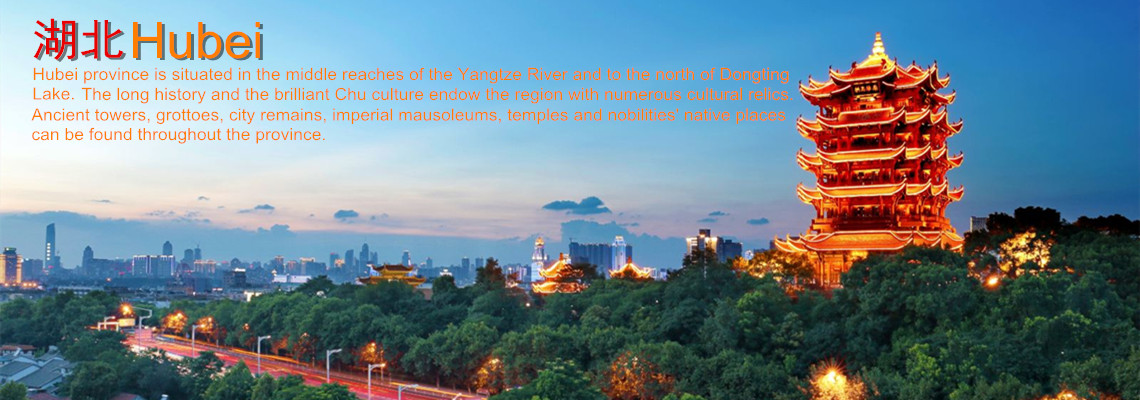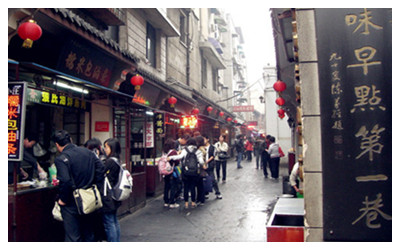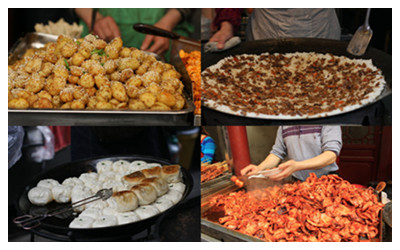Skype: neodalle-travel
Tel: +86 135 7447 2266
E-mail: sales@zhangjiajieholiday.com

 Hubu Lane of Wuhan City has a long history and is known for its breakfast snacks. In the 1940s, Xie’s doughnuts, sold by peddlers along streets, finally settled down in Hubu Lane. The snack, with its multiple varieties and delicious flavors, was well received in Wuhan city. In the early 1950s, the catering service sector entered the establishment of cooperatives. Xie’s doughnuts business was incorporated into state-owned restaurants, with weaker reputations. In the 1970s, some local residents built breakfast services at Hubu Lane to support the family. The famous snacks included Granny Shi’s hot dry noodles and Chen’s red oil beef noodles.
Hubu Lane of Wuhan City has a long history and is known for its breakfast snacks. In the 1940s, Xie’s doughnuts, sold by peddlers along streets, finally settled down in Hubu Lane. The snack, with its multiple varieties and delicious flavors, was well received in Wuhan city. In the early 1950s, the catering service sector entered the establishment of cooperatives. Xie’s doughnuts business was incorporated into state-owned restaurants, with weaker reputations. In the 1970s, some local residents built breakfast services at Hubu Lane to support the family. The famous snacks included Granny Shi’s hot dry noodles and Chen’s red oil beef noodles.
In the 1980s and 1990s, the riverside section of Zhonghua Road was home to station bases, bus terminals and a passenger ferry terminal in Wuhan city. A lot of Wuhan residents boarded ferries to go to work across the Yangtze River and Hubu Lane became a gathering place for these office workers in the morning. In 1990, Xie family members returned to the profession of serving Xie’s doughnuts. They resumed the traditional processing method and operation mode. The business was based in Hubu Lane. It marked the thriving of Hubu Lane. Since then, old residents of Wuhan would frequent the lane from various parts of the city to taste Xie’s doughnuts.
Hubu Lane snacks have become a synonym for Hankou style breakfast services. Wuhan has a popular saying, which is to “have breakfast snacks in Hubu Lane in the morning and dinner at Jiqing Street at night.”
Hubu Lane has a long history as a place to visit. The narrow lane was clearly marked on a map of Hubei and Guangdong during the reign of Emperor Jiajing of Ming Dynasty, revealing that the lane is at least a history of 400 years. Hubu Lane was popular throughout history. It was known as a neighbor to the east of the Hubu office (the ministry of revenues in feudal China). The lane, adjoining wharfs, was permeated with an endless stream of vehicles and noisy passengers. Hardworking residents of the lane cooked delicious snacks of Hankou style, featuring fresh, fragrant,  fast and hot food, to serve crowds. The reputation soared and endured. The lane has won the title of Best Snacks of Hankou Styles for six years.
fast and hot food, to serve crowds. The reputation soared and endured. The lane has won the title of Best Snacks of Hankou Styles for six years.
In 2002, Wuchang district government decided to carry out five people-friendly projects in the fields of morning snack service, health, employment, prevention of burglary and mutual assistance.
In 2003, Wuchang district government planned to improve the Hankou breakfast snack services in the lane. It rebuilt the lane with Ming and Qing dynasty architectural styles. It set up a cultural wall, 19 meters long and three meters high, along the lane, to promote Hankou style breakfast snacks. As a result of three rounds of rehabilitation, the old lane is currently equipped with charming Hubei characteristics. It has developed into a nationwide brand supplier of snacks of Hankou styles.
Hubu Lane can receive about 10,000 customers in a day. On weekends, customers can amount to 25,000. During routine holidays and big festivals, over 30,000 customers crowd the lane. On the Beijing Olympic torch relay day, the lane received nearly 40,000 customers.
Hubu Lane has become a synonym of snacks of Hankou styles. It has developed into a leading brand of Hankou-flavor snacks. The operation and management modes of Hubu Lane have turned into “textbooks” for the catering service sector, particularly the snack service sector, and created a new drawing point for Wuhan city.
 Ask Questions ?
Ask Questions ?